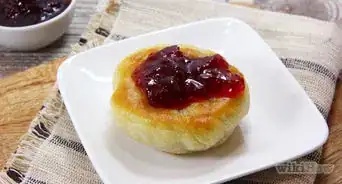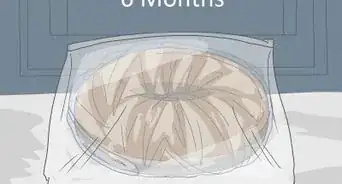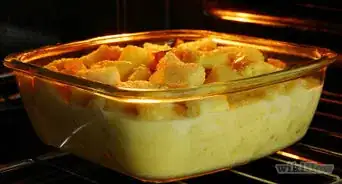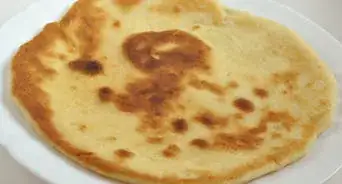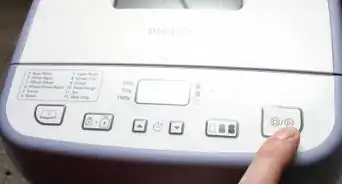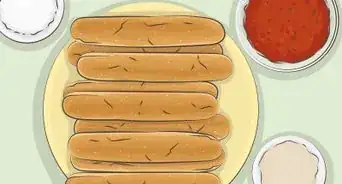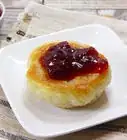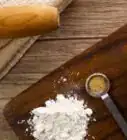This article was co-authored by wikiHow Staff. Our trained team of editors and researchers validate articles for accuracy and comprehensiveness. wikiHow's Content Management Team carefully monitors the work from our editorial staff to ensure that each article is backed by trusted research and meets our high quality standards.
The wikiHow Video Team also followed the article's instructions and verified that they work.
This article has been viewed 416,182 times.
Learn more...
You can make bread in the microwave! You won't use quite the same ingredients that you'd use for conventional bread. Indeed, this recipe is similar to a sugarless cake. You can bake a microwave simple bread in five minutes, plus mixing time.
Ingredients
- 5 tablespoons all-purpose flour
- 2-3 tablespoons oil
- 1 teaspoon baking powder
- 2-3 tablespoons milk
- 2 tablespoons water
- 1 egg
- 1 teaspoon vanilla extract (optional)
Steps
Mixing the Ingredients
-
1Combine the ingredients in a large mixing bowl. First, add five tablespoons of all-purpose bleached flour. You can also include other types of flour – almond flour, buckwheat flour, whole-wheat flour, etc. Mix these other flour types in with the all-purpose flour, if you like, but be aware that every type of flour has its own moisture content and baking properties. Changing the flour may alter the recipe.[1]
- Use chemically-treated "bleached" flour, if possible. Bleached flour contains less protein than unbleached flour, and it is better for quick breads.[2]
-
2Mix in a teaspoon each of baking powder and vanilla. The baking powder will make the bread "rise" by increasing its volume. Don't add too much, or else the dough may rise out of control![3] The vanilla is optional: it won't impact the baking process and it can give the bread a pleasantly sweet taste.Advertisement
-
3Add one egg. Break an egg and stir it thoroughly into the mixture. The egg size does not matter, although a larger egg will make a somewhat moister bread. Be careful not to leave any eggshell shards in the dough.
-
4Add 2-3 tablespoons of milk. You can use any milk that you prefer: cow milk, almond milk, rice milk, coconut milk, hemp milk. A thicker milk will make for a slightly richer bread. The main function of the milk, however, is to moisten the dough so that the flour sticks together.
-
5Add 2 tablespoons of water. Again, this functions to moisten the dough so that the flour sticks. If you don't use water, your bread will be much too dry. Mix the water into the bowl with everything else.
-
6Add 2-3 tablespoons of oil. You can use olive oil, vegetable oil, canola oil, coconut oil – anything that you prefer to bake with. The main function of the oil is to thicken the dough and moisten the bread, so you may find that taste is the biggest difference between oils.
Cooking the Bread
-
1Knead the dough. Use clean hands to mix the dough more thoroughly and stabilize the consistency. Massage the batter firmly, and try to mix the moisture evenly through. Knead the dough for 2-5 minutes, or until you can stretch it apart without it disintegrating.
-
2Shape the dough. Use clean hands to gently shape the dough into a ball or an ovular shape. This is the shape that the final loaf will take, so consider whether you need your bread to take any particular form. Score the top of the loaf with an X so that it doesn't crack while rising.
-
3Place the dough onto a microwave-safe dish. Most ceramic and glass containers are safe – but you should not microwave metal under any circumstances. Many microwave-safe containers are labeled as such. Make sure that the dish is shallow, with a flat bottom: you will need to get the bread out afterward.[4]
- Try using a large ceramic mug. This container is microwave-safe, ideally sized, and easy to remove without scalding yourself. This is best for single servings.
-
4Microwave for 5 minutes on a high heat. When you remove the bread, it should be ready to eat. If your microwave has a window, check in on the dough periodically to make sure that it isn't overcooked or rising out of control. If the dough starts to look dry, flaky, or shriveled, you might have heated all of the moisture out of it! Slice and serve your bread.
-
5Finished.
Community Q&A
-
Question5 tablespoons of flour with 6 tablespoons of total liquid, plus an egg? I got soupy mush.
 Community AnswerI also did, I had to add another 1/4 cup of flour to get it to the right consistency, and it cannot be microwaved for 5 minutes because it started to burn. I cooked mine for around 2 and 1/2 minutes.
Community AnswerI also did, I had to add another 1/4 cup of flour to get it to the right consistency, and it cannot be microwaved for 5 minutes because it started to burn. I cooked mine for around 2 and 1/2 minutes. -
QuestionIt is very delicious?
 Community AnswerYes, it is. Obviously it is better baked, but this is also a good option.
Community AnswerYes, it is. Obviously it is better baked, but this is also a good option. -
QuestionUsing self rising flour you say reduce the salt but your ingredient list does not mention salt?
 Community AnswerIt's a general rule for baking when swapping flour. It's not a large amount of salt, so you'll be fine. Just apply common sense.
Community AnswerIt's a general rule for baking when swapping flour. It's not a large amount of salt, so you'll be fine. Just apply common sense.
Warnings
- Don't put in too much milk or water. This can make it hard for your dough to stay together. If you do add too much, balance it out with more flour.⧼thumbs_response⧽
- In the microwave, bread does not form a brown crust. Microwaved bread also rises more during baking, which can cause a texture problem: the texture may be uneven due to the collapse of gas pockets that form during rising.⧼thumbs_response⧽
- Be aware that yeast-based bread bakes best in an oven or bread-maker. Thus, most microwave bread recipes use chemical leavening like baking powder in lieu of actual yeast.[5]⧼thumbs_response⧽
References
- ↑ http://joythebaker.com/2014/05/baking-101-the-difference-between-baking-flours/
- ↑ http://whatscookingamerica.net/Bread/FlourTypes.htm
- ↑ http://chemistry.about.com/cs/foodchemistry/f/blbaking.htm
- ↑ http://www.scdrecipe.com/recipes-bread/easy-microwave-bread/
- ↑ http://www.breadexperience.com/quick-breads/
About This Article
To make simple bread in the microwave, combine 5 tablespoons of all-purpose flour, 1 teaspoon of baking powder, 1 teaspoon of vanilla extract, 1 large egg, 2 to 3 tablespoons of milk, 2 tablespoons of water, and 2 to 3 tablespoons of oil in a large bowl. Knead the dough for 2-5 minutes, and shape it into an oval, scoring the top with an “X” to prevent cracking. Place the dough in a microwave-safe dish, and microwave for 5 minutes on high heat. Let the bread cool before serving! For tips on the best microwave-safe dishes to use, read on!
-Step-1-Version-3.webp)
-Step-5-Version-3.webp)
-Step-11-Version-3.webp)
